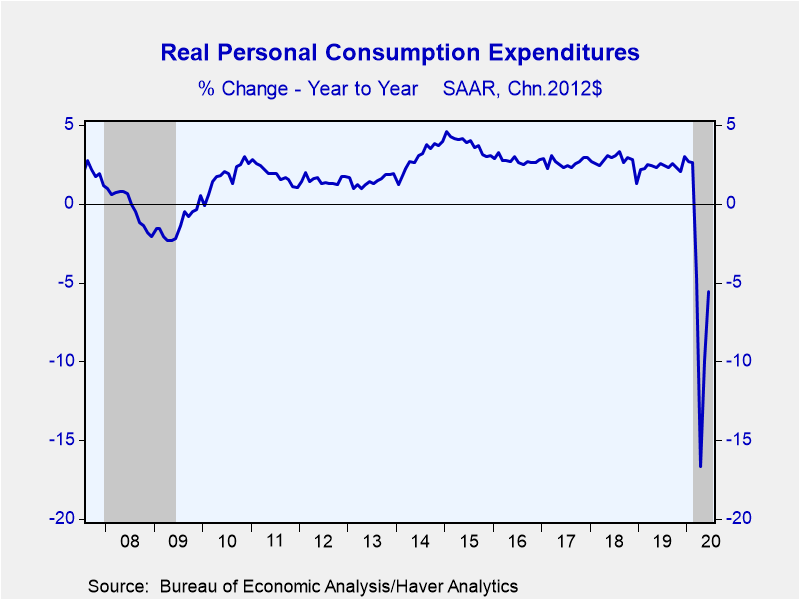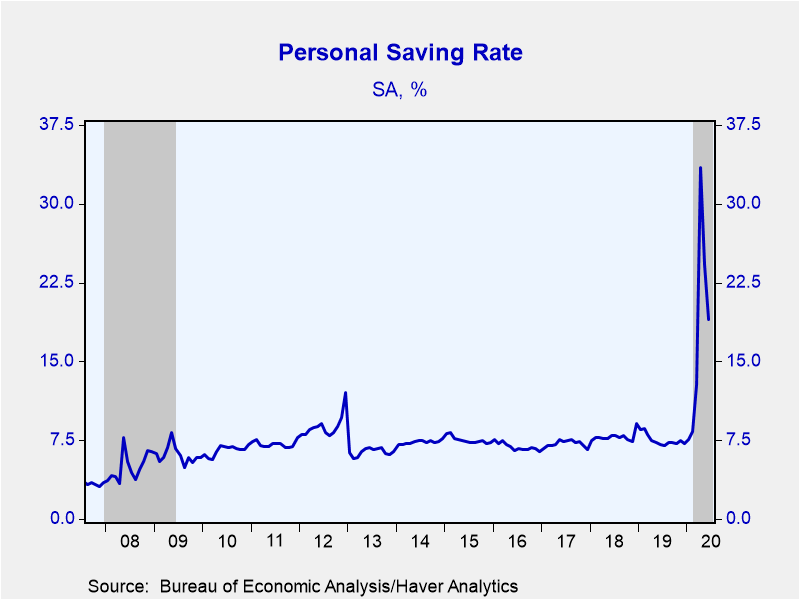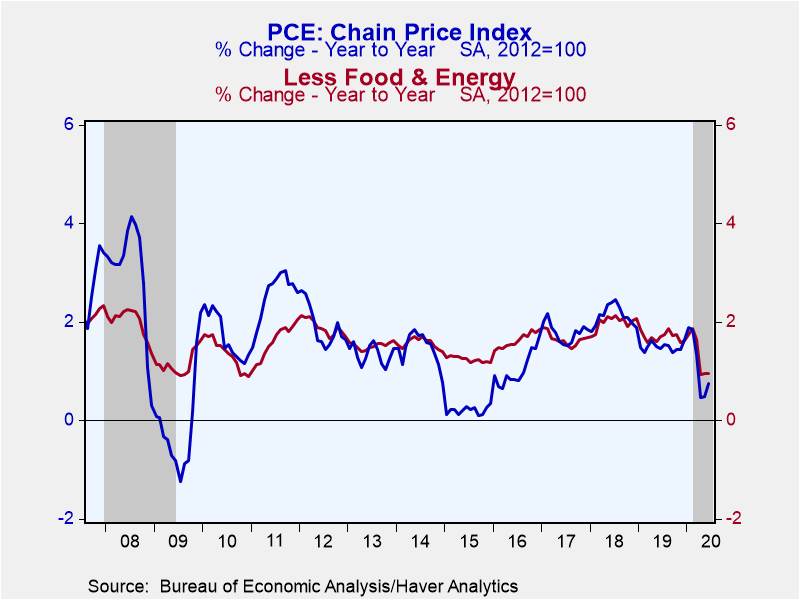 Global| Jul 31 2020
Global| Jul 31 2020U.S. Personal Spending Strengthens as Income Declines
by:Tom Moeller
|in:Economy in Brief
Summary
• Spending gain is strong for second consecutive month. • Personal income decline reflects fewer government payments. • Price inflation picks up with higher energy prices. Personal consumption expenditures increased 5.6% in June [...]
• Spending gain is strong for second consecutive month.
• Personal income decline reflects fewer government payments.
• Price inflation picks up with higher energy prices.
Personal consumption expenditures increased 5.6% in June (-4.8% y/y) following an 8.5% May rise, revised from 8.2%. Spending had fallen in 12.9% in April, revised from -12.6%. The latest gain matched expectations in the Action Economics Forecast Survey. In constant dollars, total spending rose 5.2% last month (-5.5% y/y). Real durable goods purchases increased 8.8% (11.7% y/y) during June after strengthening 28.1% in May. Spending on motor vehicles improved 7.5% (8.1% y/y) and has risen 7.2% since December. Home furniture & appliance buying jumped 8.0% (9.9% y/y) after surging 22.7% in May, while recreational goods & vehicles outlays increased 6.7% (26.0% y/y) to another record high. Real nondurable goods buying increased 4.1% (2.7% y/y) after improving 7.9% in May. The increase reflected a 29.6% surge (-0.7% y/y) in sales of clothing & shoes which came after a 39.9% jump. Gasoline & oil sales gained 8.0% (-13.0% y/y) after a 23.8% recovery as drivers returned to the road. Food & beverage purchases fell 1.0% (+5.3% y/y) but have risen 5.1% so far this year. Real spending on services improved 5.0% (-10.5% y/y) after a 5.6% gain. Spending had collapsed in the prior two months. The increase was led by a 37.6% strengthening (-43.0% y/) in sales of recreation services following a 7.7% rise. Nevertheless, spending is down 43.% year-to-date. This gain was followed by a 13.7% rise (-12.3% y/y) in outlays on health care and a 9.5% increase (-34.0% y/y) in spending on transportation. Spending at restaurants & hotels improved 18.4% (-28.3% y/y) which came after a 27.8% bounce-back from three months of decline. Financial services & insurance spending rose 1.3% (2.0% y/y). These increases were tempered by a 0.1% slip (+1.5% y/y) in outlays on housing & utilities.
Personal income declined 1.1% in June after falling 4.4% in May, revised from 4.2%. A 0.9% shortfall had been expected. The decline reflected a 9.0% falloff (+59.0% y/y) in government transfer payments as economic impact payments slid 93.4% after declining 76.6% in May. Wages & salaries improved 2.2% (-2.4% y/y) after rising 2.6% in May as employment bounced back. Proprietors income improved 5.5% (-5.4% y/y) after a 2.1% rise. Rental incomes eased 0.4% (+0.8% y/y). Receipts on assets weakened 1.3% (-3.5% y/y), due to roughly 1.3% declines in both personal interest & dividend income.
Disposable personal income declined 1.4% (+8.9% y/y) last month after falling 5.1% in May. Adjusted for price inflation, take-home pay decreased 1.8% (+8.1% y/y) after falling 5.2% in May.
Last month's strength in spending relative to income lowered the personal savings rate to 19.0% from 24.2% in May. The level of personal saving rose 192.6% y/y.
The PCE chain price index increased 0.4% last month (0.8% y/y) after edging 0.1% higher in May. The price index excluding food & energy rose 0.2% (0.9% y/y). Energy prices increased+- 4.6% (-12.8% y/y) after five months of decline. Food prices rose 0.5% (5.2% y/y), the weakest increase in the last four months.
The personal income and consumption figures are available in Haver's USECON database with detail in the USNA database. The Action Economics figures are in the AS1REP NA database
Tom Moeller
AuthorMore in Author Profile »Prior to joining Haver Analytics in 2000, Mr. Moeller worked as the Economist at Chancellor Capital Management from 1985 to 1999. There, he developed comprehensive economic forecasts and interpreted economic data for equity and fixed income portfolio managers. Also at Chancellor, Mr. Moeller worked as an equity analyst and was responsible for researching and rating companies in the economically sensitive automobile and housing industries for investment in Chancellor’s equity portfolio. Prior to joining Chancellor, Mr. Moeller was an Economist at Citibank from 1979 to 1984. He also analyzed pricing behavior in the metals industry for the Council on Wage and Price Stability in Washington, D.C. In 1999, Mr. Moeller received the award for most accurate forecast from the Forecasters' Club of New York. From 1990 to 1992 he was President of the New York Association for Business Economists. Mr. Moeller earned an M.B.A. in Finance from Fordham University, where he graduated in 1987. He holds a Bachelor of Arts in Economics from George Washington University.










